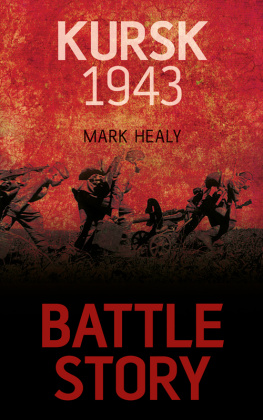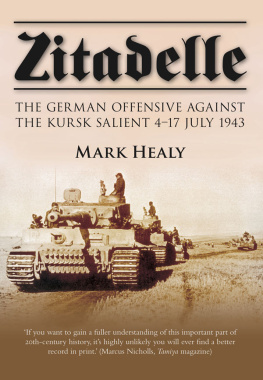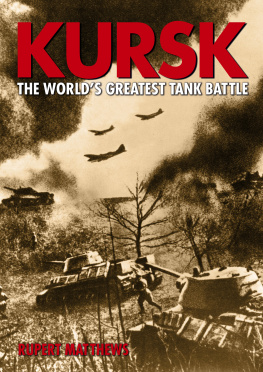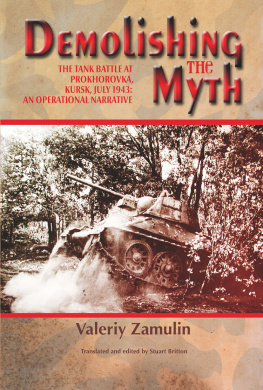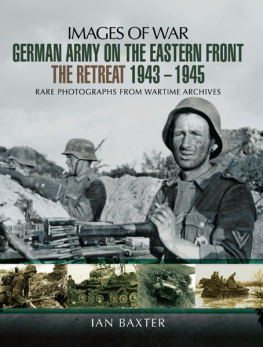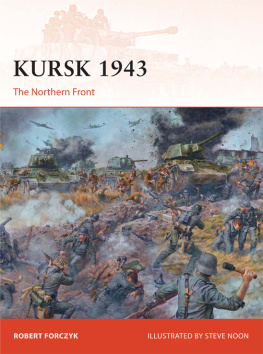CONTENTS
Conceiving the Plans: Rastenburg and the Kremlin
The Battlefield
The Commanders
The Soldiers
The Kit
The German Plan
The Preparatory Period, April5 July
The Citadel
The German Tactics
5 July Zitadelle Begins
611 July 4th Panzer Army
612 July Ninth Army
1217 July Prokhorovka
The Cost
First published in 2012
The History Press
The Mill, Brimscombe Port
Stroud, Gloucestershire, GL 5 2 QG
www.thehistorypress.co.uk
This ebook edition first published in 2012
All rights reserved
The History Press, 2012
The right of Mark Healy to be identified as the Author of this work has been asserted in accordance with the Copyrights, Designs and Patents Act 1988.
This ebook is copyright material and must not be copied, reproduced, transferred, distributed, leased, licensed or publicly performed or used in any way except as specifically permitted in writing by the publishers, as allowed under the terms and conditions under which it was purchased or as strictly permitted by applicable copyright law. Any unauthorised distribution or use of this text may be a direct infringement of the authors and publishers rights, and those responsible may be liable in law accordingly.
EPUB ISBN 978-0-7524-8128-9
MOBI ISBN 978-0-7524-8127-2
Original typesetting by The History Press
Ebook compilation by RefineCatch Limited, Bungay, Suffolk
Armstrong, Richard N., Red Army Tank Commanders , Schiffer Military History, 1994
Barnet, Corelli (Ed.), Hitlers Generals , Wiedenfeld and Nicholson, 1989
Bellamy, C., Absolute War , MacMillan, 2007
Glantz, D., Colossus Reborn , University Press of Kansas, 2005
____ Soviet Intelligence in War, Routledge, 1990
Glantz, D. and House, J., The Battle of Kursk , University Press of Kansas, 1999
Glantz, D. and House, J., When Titans Clashed , University Press of Kansas, 1995
Haupt, W., Army Group Centre , Schiffer, 1997
____ Army Group South , Schiffer, 1998
Healy, M., Zitadelle the German offensive against the Kursk salient 4 -17 July, 1943 , Spellmount 2008
Jentz, T., Panzer Truppen Vol.2, Schiffer, 1996
Krivosheev, G.F., Soviet Casualties in the Twentieth Century , Greenhill, 1997
Manstein, Erich von, Lost Victories, Greenhill, 1987
Maggenheimer, H., Hitlers War , AAP , 1998
Mellenthin, F.W., Panzer Battles , The History Press, 2008
Merridale, C., Ivans War , Faber and Faber, 2005
Newton, S., Hitlers Commander , Da Capo, 2006
____ Kursk The German View , Da Capo, 2002
Overy, R., Russias War , Allen Lane, 1997
Shtemenko,S.M., The Soviet General Staff at War , Progress Pub Co, 1985
Soviet General Staff Study; The Battle of Kursk ( trans and ed by D.Glantz and H.S. Orenstein ), Routledge, 1999
Tooze, Adam., The Wages of Destruction , Allen Lane, 2006
Volkogonov, D., Stalin , Weidenfeld and Nicholson, 1991
Warlimont, W., Inside Hitlers Headquarters , Presidio, 1964
Werth, A., Russia at War , Barrie and Rockliff, 1964
Ziemke, E.F., Stalingrad to Berlin , US Army Center of Military History, 1968
Zetterling, N. and Frankson, A., Kursk 1943: A Statistical Analysis , Routledge, 2000
Conceiving the Plans: Rastenburg and the Kremlin
When, on 23 March 1943, von Manstein called a halt to all counter-offensive operations by Army Group South, the line reached by the German forces following the capture of Belgorod on 18 February corresponded to what would become the southern face of the Kursk salient. By that date however, Manstein knew that the destruction of the Kursk salient already figured as the primary focus of the limited offensive that Hitler wished to launch as soon as the ground had dried out enough for mobile warfare. Contained in Operational Order No 5 it was given the codename Unternehmann Zitadelle Operation Citadel and had been received by Manstein ten days before. Hitler had thus embraced Mansteins forehand proposal for an early offensive as it proffered him the opportunity of addressing pressing political, economic and military issues that were crowding his strategic horizon. An early launch of the operation and rapidity in its execution lay at the very heart of the operation. Indeed, in this Operational Order and subsequent iteration, this was deemed by Rastenburg to be its absolute sine qua non.
In Hitlers mind it was essential that an early and decisive defeat be inflicted on the Red Army that would serve to draw its offensive teeth for the rest of the summer. The destruction of the Kursk salient would achieve this by nullifying the massing forces of two Soviet fronts that were deploying within it. He deemed such a victory to be essential to convince his wavering allies, such as the Finns, that the war in the East could still be won.
Furthermore, the immense booty and manpower that would accrue from victory would go far to helping the German war economy. Indeed, a short time before Hitler has signed a secret directive for the Securing of Prisoners of War, Labour Forces and Booty that stated that a prime requirement of any offensive operation in Russia must be to secure such resources. OKW estimated that 60 Soviet divisions and between five and six armoured corps were deployed within the salient, so the booty would be extensive. The anticipated trawl of prisoners would yield between 600700,000 men. It was intended that all would be shipped back to Germany for service as slave labour in the armaments factories and would help alleviate the shortage in manpower in German industry.
Additionally, and perhaps of overriding importance, was the deteriorating situation in the Mediterranean theatre. Following Operation Torch the Anglo-American landings in North Africa the previous November the Germans had sent substantial reinforcements into Tunisia. With the Italians already having made negative noises about the future conduct of the war, plans were being laid at Rastenburg that would address allied landings in southern Europe and which included steps to be taken should Italy try and leave the conflict. In the absence of a strategic mobile reserve in Germany to address such a contingency, Hitler would perforce have to remove such resources from the Eastern Front. Given the German leaders attachment to Mussolini and the strategic need to keep Allied forces as far away from the homeland as possible, his preference would be to pull out his politically reliable troops in the form of the SS Panzer Corps for rapid deployment to Italy. As these forces were already earmarked to play a central role in Zitadelle , then the overwhelming requirement to launch an early offensive seemed to Hitler to be self-evident.
That German offensive success was assured, if launched soon enough, turned on a further crucial assumption. Manstein and Hitler believed that Soviet forces in the salient would be caught by them in the process of assembling their massive forces for an offensive of their own. Hitting the Red Army at this time would find them in the process of assembling their assets and thus at their most vulnerable to the armoured assault that was the cutting edge of the German offensive design. The imperatives of time and the need to catch the Soviets forces at the right moment saw Operational Order No 5 setting the launch for the German offensive for mid-April. This was a date that, given the bad weather still obtaining in Russia at that time with the river Donets still in full flow from the snowmelt, the ground still extremely muddy and sodden and the still exhausted nature of the forces earmarked for the operation, both human and material was simply impossible.
In consequence, on 15 April the initial planning document was superseded by Operational Order No 6, which became the definitive directive for the Kursk offensive. Zitadelle was to be launched as soon as the weather situation permits. At the time Hitler had earmarked the start date for Zitadelle as 3 May just eighteen days away. In his injunction that the operation must succeed rapidly, Hitler was indicating his awareness of the potential danger that both assault forces faced by virtue of their launching attacks from salients that were themselves vulnerable to counter strokes by the Red Army. The demand in the Operational Order that German forces in the line to the north and south take special care to prepare strong defences to fend off Soviet attacks once Zitadelle began is evidence of Hitlers profound awareness of the highly speculative nature of the whole enterprise. Indeed, his subsequent and oft quoted aside to General Heinz Guderian the Inspector General of Panzer Troops some months later, that the very notion of Zitadelle made his stomach turn over, is evidence enough that he knew exactly the risks he was taking.

